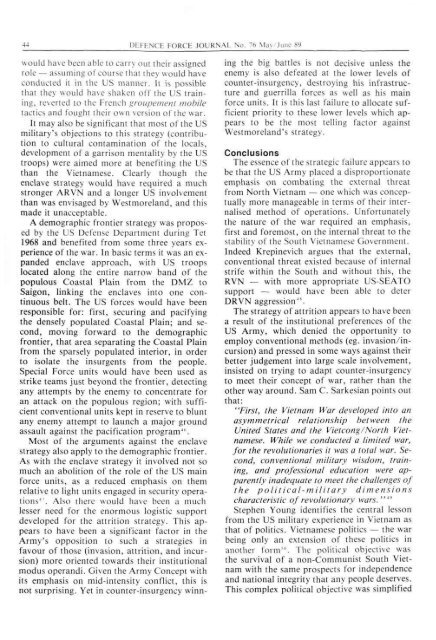ISSUE 76 : May/Jun - 1989 - Australian Defence Force Journal
ISSUE 76 : May/Jun - 1989 - Australian Defence Force Journal
ISSUE 76 : May/Jun - 1989 - Australian Defence Force Journal
- No tags were found...
You also want an ePaper? Increase the reach of your titles
YUMPU automatically turns print PDFs into web optimized ePapers that Google loves.
44 DEFENCE FORCE JOURNAL No. <strong>76</strong> <strong>May</strong>/<strong>Jun</strong>e 89would have been able to carry out their assignedrole — assuming of course that they would haveconducted it in the US manner. It is possiblethat they would have shaken off the US training,reverted to the French groupement mobiletactics and fought their own version of the war.It may also be significant that most of the USmilitary's objections to this strategy (contributionto cultural contamination of the locals,development of a garrison mentality by the UStroops) were aimed more at benefiting the USthan the Vietnamese. Clearly though theenclave strategy would have required a muchstronger ARVN and a longer US involvementthan was envisaged by Westmoreland, and thismade it unacceptable.A demographic frontier strategy was proposedby the US Defense Department during Tet1968 and benefited from some three years experienceof the war. In basic terms it was an expandedenclave approach, with US troopslocated along the entire narrow band of thepopulous Coastal Plain from the DMZ toSaigon, linking the enclaves into one continuousbelt. The US forces would have beenresponsible for: first, securing and pacifyingthe densely populated Coastal Plain; and second,moving forward to the demographicfrontier, that area separating the Coastal Plainfrom the sparsely populated interior, in orderto isolate the insurgents from the people.Special <strong>Force</strong> units would have been used asstrike teams just beyond the frontier, detectingany attempts by the enemy to concentrate foran attack on the populous region; with sufficientconventional units kept in reserve to bluntany enemy attempt to launch a major groundassault against the pacification program 4 '.Most of the arguments against the enclavestrategy also apply to the demographic frontier.As with the enclave strategy it involved not somuch an abolition of the role of the US mainforce units, as a reduced emphasis on themrelative to light units engaged in security operations47 . Also there would have been a muchlesser need for the enormous logistic supportdeveloped for the attrition strategy. This appearsto have been a significant factor in theArmy's opposition to such a strategies infavour of those (invasion, attrition, and incursion)more oriented towards their institutionalmodus operandi. Given the Army Concept withits emphasis on mid-intensity conflict, this isnot surprising. Yet in counter-insurgency winningthe big battles is not decisive unless theenemy is also defeated at the lower levels ofcounter-insurgency, destroying his infrastructureand guerrilla forces as well as his mainforce units. It is this last failure to allocate sufficientpriority to these lower levels which appearsto be the most telling factor againstWestmoreland's strategy.ConclusionsThe essence of the strategic failure appears tobe that the US Army placed a disproportionateemphasis on combating the external threatfrom North Vietnam — one which was conceptuallymore manageable in terms of their internalisedmethod of operations. Unfortunatelythe nature of the war required an emphasis,first and foremost, on the internal threat to thestability of the South Vietnamese Government.Indeed Krepinevich argues that the external,conventional threat existed because of internalstrife within the South and without this, theRVN — with more appropriate US-SEATOsupport — would have been able to deterDRVN aggression 4 '.The strategy of attrition appears to have beena result of the institutional preferences of theUS Army, which denied the opportunity toemploy conventional methods (eg. invasion/incursion)and pressed in some ways against theirbetter judgement into large scale involvement,insisted on trying to adapt counter-insurgencyto meet their concept of war, rather than theother way around. Sam C. Sarkesian points outthat:"First, the Vietnam War developed into anasymmetrical relationship between theUnited States and the Vietcong/North Vietnamese.While we conducted a limited war,for the revolutionaries it was a total war. Second,conventional military wisdom, training,and professional education were apparentlyinadequate to meet the challenges ofthe political-military dimensionscharacteristic of revolutionary wars. " 4 "Stephen Young identifies the central lessonfrom the US military experience in Vietnam asthat of politics. Vietnamese politics — the warbeing only an extension of these politics inanother form 50 . The political objective wasthe survival of a non-Communist South Vietnamwith the same prospects for independenceand national integrity that any people deserves.This complex political objective was simplified
















